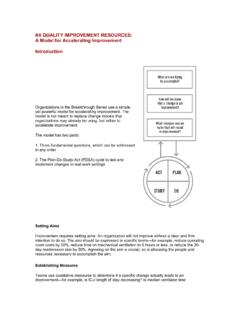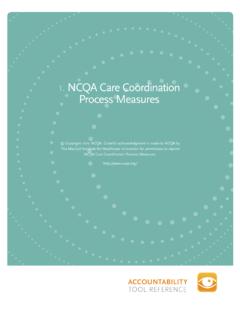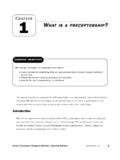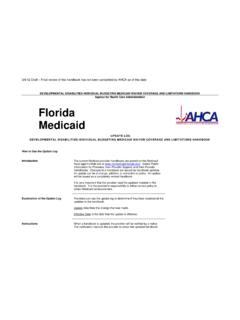Transcription of A PRACTICE COACHING MANUAL - Chronic care management
1 1 Integrating Chronic Care and Business Strategies in the Safety Net: A PRACTICE COACHING MANUAL Written by Katie Coleman, Marjorie Pearson, and Shinyi Wu Edited by Cindy Brach Prepared for Agency for Healthcare Research and Quality Department of Health and Human Services 540 Gaither Road, Rockville, MD 20850 | April 2009 | Contract No: HHSA2902006000171 Table of Contents 3 chapter 1: introduction .. 5 chapter 2: WHAT IS PRACTICE COACHING ?.. 9 Why PRACTICE COACHING ? .. 10 What Roles Do PRACTICE Coaches Play? .. 11 What Do PRACTICE Coaches Do? .. 11 How Is PRACTICE COACHING Structured? .. 13 Who Serves as a PRACTICE Coach? .. 14 Which practices Benefit From COACHING ? .. 14 Does PRACTICE COACHING Work?.. 15 What Makes a Good PRACTICE Coach?
2 16 How Much Does COACHING Cost? .. 18 How Does COACHING Compare to Participating in a Collaborative? .. 18 Successful COACHING Case Study # 20 Successful COACHING Case Study # 21 chapter 3: AN APPROACH TO PRACTICE COACHING ..22 In a Nutshell .. 23 PHASE I: Laying the Foundation for Success .. 24 PHASE II: Active PRACTICE COACHING .. 27 Suggested Modifications to our PRACTICE COACHING Approach .. 35 APPENDIX OF MEETING AGENDAS AND TOOLS ..41 EXAMPLE: PRACTICE Team Orientation Call 42 EXAMPLE: PRACTICE Team Site Visit Preparation Call .. 43 EXAMPLE: Assessment Day Agenda .. 44 TOOL: Clinic Observation Assessment .. 45 EXAMPLE: Learning Session Agenda .. 47 TOOL: The Change Your PRACTICE Menu .. 49 TOOL: Getting Started Logistics .. 51 TOOL: Tell Us What You Think!
3 54 2 Acknowledgments The authors gratefully acknowledge Ed Wagner, Brian Austin, and Dona Cutsogeorge from the MacColl Institute for Healthcare Innovation; Wendy Jameson and Hunter Gatewood from the California Health Care Safety Net Institute; and Anne Tillery and Sarah Bylsma at Pyramid Communications who helped to develop, edit, and format this work. The authors also thank all of the many individuals who contributed by sharing their expertise and reflections on PRACTICE COACHING , including: Mike Hindmarsh, MA | Consultant, MacColl Institute for Healthcare Innovation, Principal, Hindsight Healthcare Strategies Rick MacCornack, PhD | Chief Systems Integration Officer, Northwest Physicians Network Director, South Sound Health Communication Network Terry McGeeney, MD, MBA | President and CEO, TransforMED Marjorie M.
4 Godfrey, PhD(c), MS, RN | Instructor, The Dartmouth Institute for Health Policy and Clinical PRACTICE , Director, The Clinical Microsystem Resource Group Nicole Van Borkulo, Med | Principal, NVB Consulting Inc., Consultant, Washington State Collaborative for Better Health Darren A. DeWalt, MD, MPH | Assistant Professor of Medicine, University of North Carolina at Chapel Hill, Quality Improvement Consultant, Improving Performance in PRACTICE Peter Margolis, MD, PhD | Professor of Pediatrics, Cincinnati Children's Hospital Medical Center, Center for Health Care Quality, Quality Improvement Director, Improving Performance in PRACTICE Patricia L. Bricker, MBA | State Director, Pennsylvania Improving Performance in PRACTICE Allyson Gottsman | Associate Director and Improving Performance In PRACTICE Director, Colorado Clinical Guidelines Collaborative 3 Marjie Harbrecht, MD | Medical/Executive Director, Colorado Clinical Guidelines Collaborative Julie Schilz, BSN, MBA | Manager, Improving Performance in PRACTICE and Patient Centered Medical Home, Colorado Clinical Guidelines Collaborative Zula Solomon, MBA | Improving Performance in PRACTICE and Patient Centered Medical Home, Quality Improvement Coach, Colorado Clinical Guidelines Collaborative Linda Lawrence Cade, MSN, NP, CDE | PRACTICE Redesign Coach, Humboldt-Del Norte.
5 Independent PRACTICE Association and Open Door Community Health Centers Alan Glaseroff, MD | Chief Medical Officer, Humboldt-Del Norte Foundation Mary Ruhe, RN, MPH | EPOCHS Project Coordinator, Family Medicine Research Division at Case Western Reserve University Kurt C. Stange, MD, PhD | Professor of Family Medicine, Epidemiology and Biostatistics, Oncology and Sociology, Case Western Reserve University 4 5 chapter 1 introduction chapter 1: introduction Welcome! Most likely, if you re reading this you are interested in improving health care quality through PRACTICE COACHING . This PRACTICE COACHING MANUAL aims to help effectively and efficiently improve clinical quality in an ambulatory setting by providing: AN OVERVIEW of what PRACTICE COACHING is and how a variety of settings have used it to improve care.
6 A SUMMARY of important characteristics and skills to look for when recruiting or training a PRACTICE coach. A DESCRIPTION of a time-limited PRACTICE COACHING intervention that includes a series of activities, companion agendas, and tools. This PRACTICE COACHING MANUAL accompanies a comprehensive Web-based toolkit, Integrating Chronic Care and Business Strategies in the Safety-Net. The toolkit outlines a sequence of steps that PRACTICE teams can use to efficiently improve clinical quality along the lines of the Chronic Care Model. It also includes presentations, assessments, data tracking sheets, and sample action plans for use by teams as they transform their care. The toolkit and this PRACTICE COACHING MANUAL work together and refer to each other.
7 We know that clinical teams often need help and support to effectively improve care, and we believe PRACTICE COACHING may be useful to them as they do this work. This MANUAL provides instructions and materials needed to support those using Integrating Chronic Care and Business Strategies in the Safety-Net to transform care. The development of these two resources grew out of a desire to help primary care teams improve clinical quality efficiently and effectively. Both are based on the Chronic Care Model (CCM), an evidence-based framework that has helped hundreds of clinical practices transform their daily care. The Chronic Care Model (CCM) is designed to help practices improve patient health outcomes through changing the routine delivery of ambulatory care.
8 The Model calls for a number of interrelated system changes, including a combination of effective team care and planned interactions; self- management support bolstered by more effective use of community resources; integrated decision support; and patient registries and other supportive information technology. 6 Most often, the CCM has been implemented through Breakthrough Series (BTS) Collaboratives, an organized quality improvement approach that brings together practices from a variety of organizations four times a year to learn from leaders and colleagues about improving care. In between these learning sessions, teams return to their practices and try out new ways of delivering care through small, short-cycle changes called Plan-Do-Study-Act (PDSA) cycles.
9 The practices that have participated in BTS Collaboratives to learn the CCM improved the care they provided for patients and improved patient health In our 10 years of experience with BTS Collaboratives, we have seen that they are often expensive to organize and require practices to take time out from providing patient care to attend learning sessions. Often the practices that are willing and able to do this are more highly motivated and well-supported than others. We sensed a need for a less time- and resource-intensive intervention that would: Make the tools and concepts taught in the Collaboratives available to more practices , and More closely integrate the business strategies necessary to sustain clinical change in the long term. The MANUAL is created primarily based on our PRACTICE COACHING experience during the AHRQ-funded pilot project Integrating Chronic Care and Business Strategies in the Safety-Net.
10 It captures our coaches approach to the teams, lessons learned from our experience, and feedback from the teams. It is supplemented by a literature review and interviews with leaders from other national COACHING initiatives. chapter 2 reviews the many forms that PRACTICE COACHING can take and summarizes COACHING as it is depicted in the literature and by leaders in the field. chapter 3 provides step-by-step instruction for those interested in replicating the 10-month AHRQ pilot COACHING intervention. Sample agendas and tools are available in the Appendix. This COACHING model is being evaluated as part of a randomized trial. THIS PRACTICE COACHING MANUAL IS DESIGNED FOR: Clinic or hospital leaders who want to use COACHING to initiate or spread improvement efforts from one site to others; 7 8 Quality improvement coaches, improvement leaders, and anyone else interested in new ideas about how to facilitate PRACTICE improvement; and Public health departments, multistakeholder collaboratives, and medical associations or other organizations interested in improving clinical quality in medical practices .


















